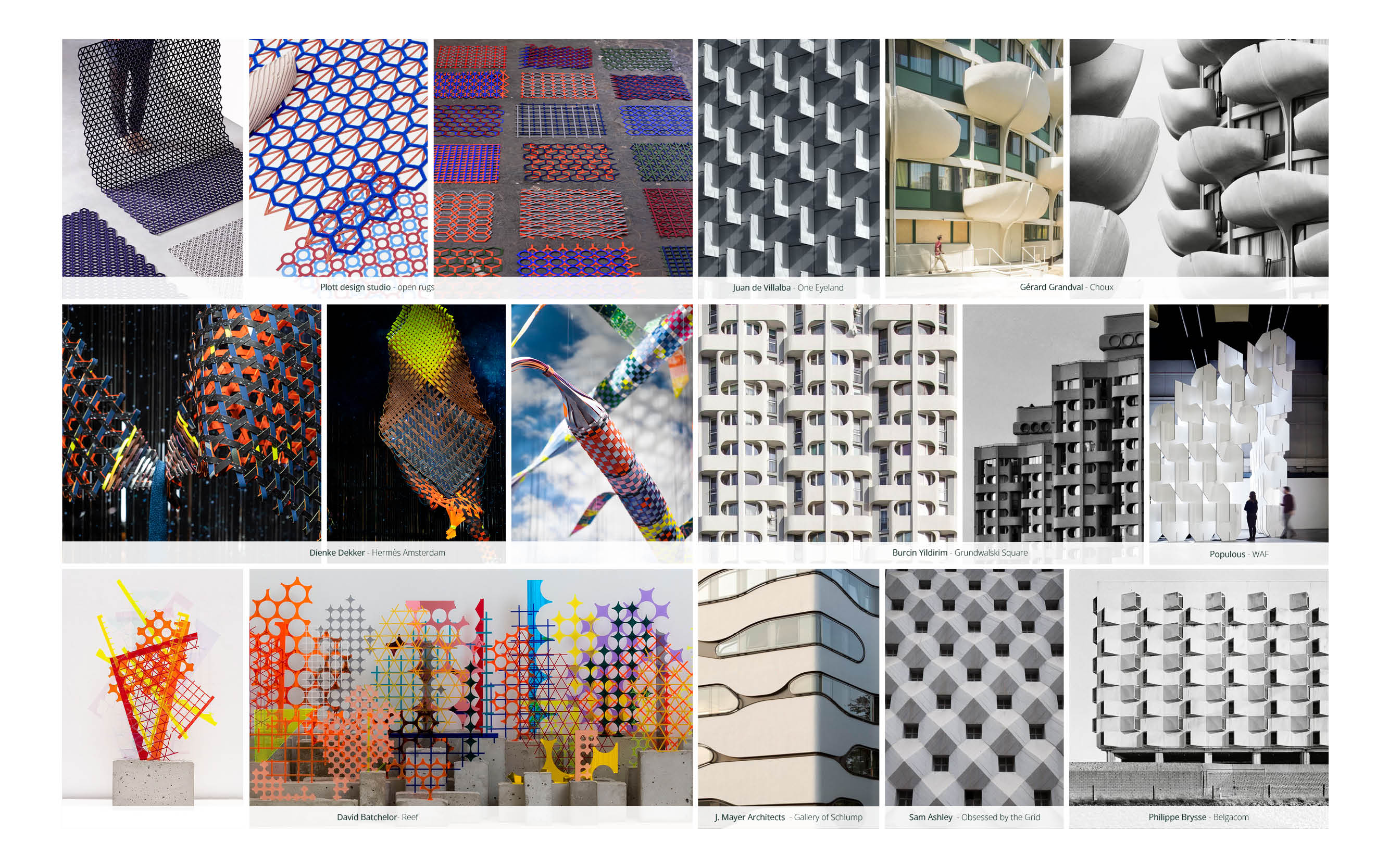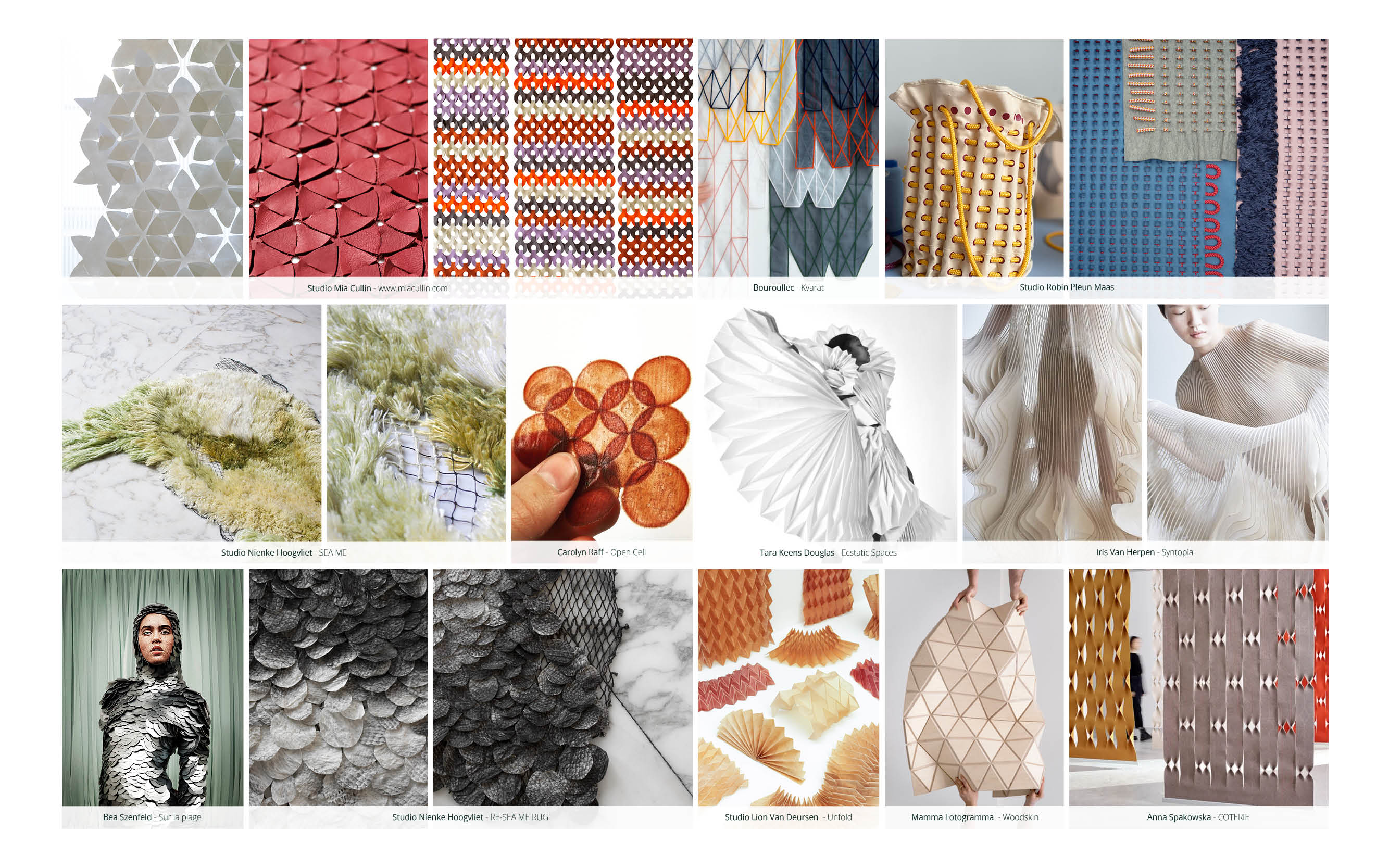3. Circular Open Source Fashion¶
References & Inspiration¶
For Week 03, we explored ways of achieving open source circularity concepts in the use of clothing materials. Looking at small modules of fabric that allow scraps to be reused, and interlocking shapes to avoid producing too much scrap when cutting.
To do this, I found inspiration from quilting and collected geometrical architectural references. That also seemed interesting to me to look at folds, links and the principle of nets onto which modules are grafted.


get inspired!
Some websites I consulted and enjoyed during my researchs :
Mia Cullin Nienke Hoogvliet Carolyn Raff Robin Pleun Anna Spakowska Wood Skin Studio Plott Stire Linnemann Dienke Dekker Laurent Kronental Artsthread Cluster London
These references are available in a open Miro board with other weeks inspirations : INSPIRATIONS
Research & Ideation¶
- I started my researchs by grouping all the textiles I had scraps of and which had different structures and softnesses.
Tip
I am now doing more and more sewing (trying to not buy new clothes), and I source my fabrics mainly from Cyclup in Brussels and at the Green Fabric mercerie. In Paris, I am sometimes going to La Réserve des Arts in Pantin, and to Les Coupons de St Pierre in Montmartre.
- I began the laser work by producing matrixes with cutting & engraving parameters comparison on the different textiles. Usually, it is available on each laser machine software, in the example files.
It is looking like that on StudioBeamBox :


It took so long to download the matrix file onto the machine at this time, that I used it on plenty of other materials from Green Fabric too, such as 4mm wood, paper, wood card and acrylic, in order to anticipate other laser cutting projects. These matrixes allow me to reduce the choice of parameters for my cutting/engraving tests in each material.
Tip
The shapes and dimensions of each part, as well as their proximity on the cutting table can still have an impact on the laser parameters to be fine-tuned for each project.

- I started experimenting with modules by laser-cutting different geometric shapes out of white paper. The aim of my shapes was to fit into a square, so as to keep the spirit of slabs that connect identically in height and width.


- I experimented with internal notches on my shapes, and also with circular perforations to give volume to the paper without adding extra parts or creating waste. I have seen this idea in Fashion Design projects such in the work of Jisoo Jang.

- By rotating & duplicating my shapes in Illustrator, I gradually arrived at an octagon.

This shape seems great because of its equivalent in height/width, and also because of the multiple geometrical patterns it can generate around it in the material cut-out. I imagine re-using these small geometric scraps to make jewellery :)
Tools¶
Process and workflow¶
- After paper I used one same octagonal shape, and compared 2 options of notches and 2 materials on textile. I used a wax fabric (cotton little bit coated), and a black polyester. These fabrics came from an old shelf cover that I had sewn for my previous apartment. I washed and ironed it to cut it into sheets that fit the size of the laser cutter plate.


Here are some tests of assembly with the two options of notches. I thought it would be interesting to work in two-tone to distinguish the modules more clearly.



And here's a little test with grey felt, a material that responds very well to laser cutting and engraving and to this type of notched assembly. I used originally this material to make my computer sleeves and some storage baskets.

Step¶
- The contour of my modules 1 and 2 was obtained on Illustrator software. By creating a 75x75mm square, rotating it at 45° by clicking "copy" to keep the original, then using the "reunion" option of the pathfinder tool of Illustrator.
Tip



- I have then draw some notches (2 types) that I have also duplicated using the same rotating tool.
3 and 4 are cutting nesting of each modules adapted to our laser-machine dimensions (600x375mm).